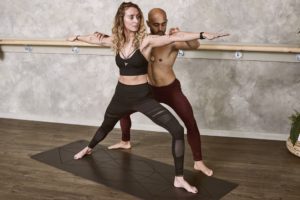
Movement Orientation
From https://www.alexandertechnique.com/at.htm
What is the Alexander Technique?
What are the Benefits of Lessons or Classes?

Movement Orientation
“The Alexander technique is a way of learning how you can get rid of harmful tension in your body.”Although certainly not a full definition of the Alexander Technique, this is a good start.*
“The Alexander Technique is a way of learning to move mindfully through life. The Alexander process shines a light on inefficient habits of movement and patterns of accumulated tension, which interferes with our innate ability to move easily and according to how we are designed. It’s a simple yet powerful approach that offers the opportunity to take charge of one’s own learning and healing process, because it’s not a series of passive treatments but an active exploration that changes the way one thinks and responds in activity. It produces a skill set that can be applied in every situation. Lessons leave one feeling lighter, freer, and more grounded.”
“The Alexander Technique is a method that works to change (movement) habits in our everyday activities. It is a simple and practical method for improving ease and freedom of movement, balance, support and coordination. The technique teaches the use of the appropriate amount of effort for a particular activity, giving you more energy for all your activities. It is not a series of treatments or exercises, but rather a reeducation of the mind and body. The Alexander Technique is a method which helps a person discover a new balance in the body by releasing unnecessary tension. It can be applied to sitting, lying down, standing, walking, lifting, and other daily activities…”
“The Alexander Technique is an intelligent way to solve body problems.”
– So begins an excellent article-length introduction to the Technique.
More short descriptions of the Alexander Technique
“The release of unnecessary muscular tension is vital to our well-being; if our muscles are habitually over-tightened our bodies become distorted, unbalanced and compressed. The Alexander Technique offers a way to let go of such destructive tension by learning to monitor the way we coordinate ourselves in any activity so that we can carry out that activity with … the minimum of strain.”
“Most of us after the age of 3 or 4, learn tension patterns that interfere with the natural easiness, balance, support, and freedom of movement we all had as children. These tension patterns of slumping and so-called ‘good posture’

Lost in western civilization: Primal Posture
become so habituated that they feel normal; yet to whatever degree a person has one or both patterns, their movements are limited.”
“A preventative approach, the Alexander Technique provides a powerful method… that focuses on improving your awareness of how you move (in order) to increase your ease of movement.”
“The reason (the) Alexander Technique has such wide application is that at the root of much discomfort and pain lies a pattern of habitual tightening, of which we may be unaware. The misuse of ourselves is especially characterized by a tightening of the muscles in the neck and back, causing stiffening of the head on the spine. This tightening also blocks information regarding our sense of balance and interferes with our innate poise and movement. Over time we adapt to – and compensate for- the sensory misinformation conveyed by our habits and lack of self-awareness. We sometimes accept our misuse as normal, not realizing the extent to which we are contributing to our own physical discomfort and stress.”
Benefits of the Alexander Technique

Balance is Key To Sensible Movement
Excess tension in your body can cause a variety of unpleasant symptoms and it can interfere with your ability to perform activities well. Therefore it is not surprising that most people come to the Alexander Technique because they are in pain (backaches, sore necks and shoulders, carpal tunnel syndrome etc.) and/or because they are performers who want to improve the quality of their singing, playing, acting or dancing.
People of all ages and lifestyles have used the Technique to improve the quality of their lives. The Alexander Technique has been taught for over a century, and during that time a number of prominent individuals have publicly endorsed the Technique. Among them are:
Authors: George Bernard Shaw, Aldous Huxley, Robertson Davies, Roald Dahl, Jane Brody (Personal Health Columnist for the New York Times – Read an article on the Alexander Technique by Jane Brody)
Actors: Paul Newman, Jeremy Irons, Joel Gray, Mary Steenbergen, Julie Andrews, Patrick Stewart, Kevin Kline, Joanne Woodward, John Cleese, Alan Rickman, John Houseman, Robin Williams, James Earl Jones, Christopher Reeve, Judi Dench, Ben Kingsley, William Hurt, Keanu Reeves, Hillary Swank. Heath Leger, Pierce Brosnan, Juliette Binoche
Musicians: Paul McCartney, Sting, Julian Bream, Yehudi Menuhin, James Galway, Sir Colin Davis
Others: Professor Niko Tinbergen (Winner of Nobel Prize in Medicine), Frederick Perls (Originator of Gestalt Therapy), Moshe Feldenkrais (Originator of the Feldenkrais Method), Terry Gross (host of the NPR radio program “Fresh Air”), John Dewey (the American Philosopher – John Dewey and F. Matthias Alexander Homepage), Dr. Andrew Weil, Jacqueline Kennedy Onassis, Karl Popper (philosopher), Benjamin Libet (investigator of human consciousness), Sir George Trevelyan
The Alexander Technique is another movement orientation discipline that can’t help but do you good. The only problem I have with it is it’s vague. Unlike Perfect Posture instruction it doesn’t connect the dots and give reference points on body positioning. It may take more time to develop a “sense of balance”.

